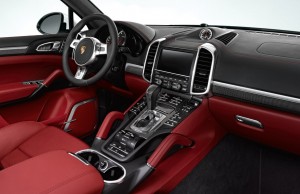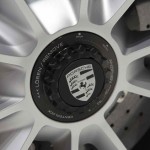Tag Archives: gt3
2019 Porsche 911 GT3 RS: What Can You Get Starting at $188,550?
The 2019 Porsche 911 GT3 RS was just unveiled prior to the 2018 Geneva Motor Show. The pricing of the sports car starts at $188,550, and it promises more downforce, more power and better grip.
Here are the top 3 features of the new Porsche 911 GT3 RS:
1. Engine and Performance
The Porsche 911 GT3 RS uses the same 4.0-liter naturally-aspirated flat-six engine used by the 911 GT3. However it has been slightly tuned to deliver 520 hp and 346 lb-ft or torque. The numbers are 20 hp and 7 lb-ft up from its non-RS sibling.
The output of the 911 GT3 RS is distributed to the rear-wheels via a seven-speed PDK dual-clutch transmission—ditching the six-speed manual of the plain 911 GT3. The setup allows the RS to accelerate from zero to 60 mph in just three seconds. Then the top speed of the sports car is capped at 193 mph.
The extra power of the 911 GT3 RS is complemented by the chassis derived from the 911 GT3. It includes Porsche Active Suspension Management, Porsche Torque Vectoring Plus and rear steering. In addition, it comes with new helper springs located at the front axle. All these are partnered with a set of standard active dampers that help improve the grip of the vehicle.
2. Exterior
The 2019 Porsche 911 GT3 RS benefits from all the goodies found in the 911 GT3 but with a few tweaks to help improve its aero and design. Among the changes are the wider body, carbon fiber hood and fenders, magnesium roof, larger front lip spoiler and side skirts, huge fixed rear wing as well as the optional forged magnesium wheels from the Weissach Package.
3. Interior
The new Porsche 911 GT3 RS only features two seats. The bucket seats come in carbon fiber shells. Aside from the other interior elements within the 911 GT3, the RS model also boasts lightweight glass and reduced sound insulation.
Photos
Check out the official photos of the 2019 Porsche 911 GT3 RS in the gallery below:
Porsche RS Models Will Not Get Manual Transmission
The Porsche RS models will not be getting a manual transmission. A company executive revealed they decided to go on that direction because the demand for it might not be high enough to justify its production.
“RS means Renn Sport, which means it has to be quick on the track, that it’s all about fast times on the track, and that means the PDK,” Andreas Preuinger, Porsche’s head of Motorsport Division, told CarAdvice during an interview.
“The PDK has advantages on the track that can’t be beaten by a manual, and the ones who prefer the manual transmission are not typically the track rats as we call them, but they are those who like to enjoy their cars on the normal public roads. I would say a GT2 RS with a manual option would have a four or five percent share of the market, we couldn’t justify that,” he explained.
Preuinger ensured that the manual stick-shift will remain as an offering in their GT models. He stated that they had success in their manual transmission cars. He estimated that putting it in the RS might yield a 30 percent share. However, they also projected that the demand might diminish and the figures might vary in different markets.
The decision of Porsche to ditch the manual in favor of the dual-clutch PDK for their RS models may not sit well to purists but Preuinger definitely had a point, especially on the “demand” factor. After all, they are running a business and numbers really do matter.
To the company’s credit though, they tried this formula before in their 911 GT3 RS to satisfy a segment of its market who were yearning for a manual shift stick. Unfortunately, it will not be the case this time.
3 Reasons Why the Mercedes-AMG GT3 Edition 50 is Awesome
The Mercedes-AMG GT3 Edition 50 was just unveiled. As its name implies, the car was made in line with the celebration of the 50th anniversary of AMG.
The special edition car offers many upgrades compared to the standard Mercedes-AMG GT3, which makes it a must-have for collectors. Here are the key features of the vehicle that truly makes it awesome:
1. Engine
The Mercedes-AMG GT3 Edition 50 still uses the 6.3-liter naturally-aspirated V8 engine. The unit is capable of producing 622 hp and 635 Nm of torque. The power is distributed through a six-speed sequential racing transmission. The mentioned elements allow the auto to sprint from zero to 100 km/h in merely 3.8 seconds. The maximum speed of the vehicle is electronically-limited to 332 km/h.
It should be noted that the 6.3-liter V8 used by the AMG GT3 is already a rare hardware and it is the last naturally-aspirated engine to be used by Mercedes in its cars. It was used by the Mercedes-Benz SLS AMG GT3 but the Mercedes-AMG GT3 carried it over due to its reliability, low-maintenance and power.
2. Styling
The Edition 50 car sports a more aggressive look than its original version. It is fitted with new carbon fiber materials plus its bumpers, side skirts, diffuser and rear wing have been redesigned. The body of the auto takes a gray metallic finish. The noticeable additions in the special GT3 include the big vents above the front fenders and “50 Years of Driving Performance” badges on the sides.
Inside, the car gets new carbon fiber racing seats, rollcage and GT3-inspired, racing steering wheel. A couple of upgrades can be seen in its instrument cluster too. The same “50 Years of Driving Performance” badges can be found in its safety harnesses.
3. Exclusivity
The Mercedes-AMG GT3 Edition 50 is only limited to five units. It is specifically made for collectors who love motorsport.
Photos
Check out the photos of the Mercedes-AMG GT3 Edition 50 in the gallery below:
Top 3 Things to Look Forward to in the New Porsche 911 GT3 RS

The prototype for the Porsche 911 GT3 RS was spotted cruising the roads of Germany in a series of spy shots.
After unveiling the new Porsche 911 GT3 at the 2017 Geneva Motor Show, we are in for another treat again from the German automaker. Latest spy shots reveal that a Porsche 911 GT3 RS is in the works.
What have we learned so far and what can we expect from the upcoming sports car? Here are the top three things to look forward to when it comes out in the market:
1. Design Changes
From the looks of it, the next 911 GT3 RS is just a cosmetically enhanced version of the 911 GT3. The car has wider fenders with new air intakes at the rear part, revised front bumper, updated headlamps and added vents on the hood.
The interior of the 911 GT3 RS might see subtle upgrades compared to the standard 911 GT3. It’s hard to tell for now basing from the angle the spy pictures were taken. It should get new sporty leather trims as well as new pedals and steering wheel.
2. Engine Boost
The major change should come from the sports car’s power unit. Currently, the 911 GT3 is packing 500 hp. The 911 GT3 RS is expected to get an extra 20 hp to 40 hp in its flat-six engine compared to its standard version. The power of the car will probably be complemented with a manual transmission gearbox to attain optimum performance.
3. Arrival
Looking at the spy images, the prototype is almost in its final stage of development. Therefore, the possible debut of the vehicle is in September of this year. The likely venue for its world premiere is at the 2017 Frankfurt Motor Show, since that is the major auto show coinciding with that period.
Photos
Check out the recent spy shots of the upcoming Porsche 911 GT3 RS while it was being tested in Germany in the gallery below:
2017 Acura NSX GT3 Race Car Shows Up At NY Auto Show
It was safe to assume we’ve seen the last of the Acura NSX because it has just went on sale last month with the launch of its online configuration. But then, it just showed up at the New York Auto Show with a GT3 variant of the Acura NSX. There was an announcement too that Acura plans to turn this model into a GIA GT3 race car this fall based on a report.
In terms of overall design, there is almost no difference between the NSX and the NSX GT3, except for the latter’s new hood that sports a larger vent for cooling down the engine. The fascias, headlights and front grille are also the same. What’s new is the larger front spoiler that extends several inches away from the fascia, giving the NSX GT3 a more truck-like appearance.
On the sides, the GT3 is more toned down than the NSX. The mirror arm sits almost vertical and the mirror housing is smaller. The aggressive body line we’ve seen on the NSX is no more. Instead, it has been toned down to fit the smoother side skirts that transition into the rear wheel arches and the rear quarter panels. This was probably done to assist in air distribution.
To make it lightweight, the GT3 was wrapped with a lightweight, aluminum-intensive space frame. The main color is white, though there are black accents around the grille and the fascia’s flics, hood vent and rear air intakes.
There is not much information yet about the drivetrain, though we have a thinking that the GT3 will be powered by a 3.5-liter, 75-degree, twin turbo DOHC V-6 that has the same engine specs as the road-going NSX. The engine block, cylinder heads, valvetrain, crankshaft and pistons will be similar as well.
The current road-going NSX can produce 573 horsepower and 476 pound-feet of torque. The GT3 will most likely upgrade these figures.
We can base the GT3’s future pricing to the Porsche 911 GT3 R, which has a current price tag of $479,216.
Spy Shots Of 2018 Porsche 911 GT2 Leaked
Everyone thought that Porsche was testing a more extreme version of the latest 911 GT3 when spy photos of a new prototype resembling the car came out. However, the company clarified that it’s an early tease for the 2018 Porsche 911 GT2.
Andreas Preuninger, 911’s chief engineer, confirmed through a report that the 911 GT2 will be part of the 991-series 911 family. The company, in fact, already has mules out on the streets for the next generation car.
At the front, this car would most likely have a larger intake than those on the GT3 RS while at the rear, the hidden vents are on either side of the bumper, typically indicating a turbocharged engine. These cannot be found on the GT3 RS.
We can expect the GT2 to have the same engine as the 911 Turbo, albeit with more power. If it will have the latest Turbo S, which can now deliver 580 horsepower from the twin-turbocharged 3.8-liter flat-six, then the GT2 could crank up to 620 hp.
The release of a GT2 would be late, in all honestly, so some are even expecting Porsche to just skip ahead to the GT2 RS. If the brand does this, it should be ready to power the GT2 RS with a capacity of 660 hp. The previous GT2 RS already had 620 hp, remember.
All of this power can be found on the rear wheels, and via a most likely seven-speed manual clutch transmission. Since the 911 models have four-wheel steering system, the GT2 will probably also come packed with this feature.
There were talks that the GT2 would officially come to the end of its production, especially because the Turbo models are offering better performance than previous GT2s. The rear-wheel-drive layout of the GT2 can also be a challenge for some people, but aren’t we glad Porsche didn’t give in to the temptation.
The GT2 will be released in 2018.
2017 Porsche 911 R Is The 911 GT3 We’ve All Been Waiting For
Porsche’s 911 GT3 was welcomed with a lukewarm response despite having one of the best automatic transmission ever built mainly because Porsche purists are looking for a track-ready Porsche 911 with a manual gearbox.
Although the Porsche 911 GT3 shifts amazingly quick and was tuned to deliver fast lap times around the race track, there was still nothing better than a car with three pedals and a stick. Thankfully, the new Porsche 911 R is making its debut at the Geneva Motor Show today.
New images have already been leaked of this manual transmission 911 R, but there’s also another that set this thing apart from the 911 GT3—the 911 R has no rear wing.
In terms of exterior, these two exteriors are identical to each other except for the fact that the Porsche 911 R has no rear wing. But overall, they have the same bumpers, rear fenders, wheels, side skirts and mirrors.
The only thing that sets the 911 R apart is the engine lid, which has a conventional grille and retractable spoiler taken from the Porsche Carrera models. It also has a redesigned front spoiler lip and rear underbody diffuser.
Inside, the 911 R features a sporty interior with few comfort features just like the standard 911. Some other interior elements are bucket seats, Alcantara-wrapped steering wheel, and lightweight door panels.
For the 911 R, Porsche used the larger, 4.0-liter in the GT3 RS. The output is similar to the RS with 500 horsepower and 339 pound-feet of torque. The biggest change, of course, is that the 911 R shifted to a manual gearbox with no option for an automatic transmission.
The Porsche 911 R is made for race track purists, but the manual transmission came with disadvantages, too. The 0-60 mph is achieved in 3.7 seconds. This falls behind the GT3 and GT3 RS, which can complete it in 3.3 and 3.1 seconds, respectively.
The Porsche 911 R will probably sell for $120,000. Only 600 units will be produced.

































































